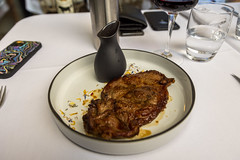This particular visit to France was a work trip, with visits to both a partner company in Grenoble, France, and another visit to the Paris Air Show (yeah, life is hard, isn’t it?). This time I took a completely different approach on getting to Grenoble; we fly into Paris Charles De Gaulle and took the TGV down to Lyon, catching a local train to Grenoble. This looked great on paper, but two major hitches in that plan: first, the baggage handlers at CDG took a full hour and 40 minutes to unload the aircraft and deliver my bags, which was just slow enough that I barely missed my train to Lyon. But after an hour and half relaxing with an espresso, I caught the next one, with a surprisingly smooth and efficient trip to Lyon (so, travel hint here: take the TGV: it’s one of the best train services out there). But then the trip from Lyon to Grenoble was interesting: recent rains had resulted in a landslide over the tracks, so they had to route us on a very scenic, but very circuitous, trip through the French Alps via Chambéry. However, we still arrived in Grenoble in time to get settled into our hotel and meet up with our hosts at one of their favorite spots in downtown Grenoble: Brasserie Chavant.
Located just a block from Place Victor Hugo, Brasserie Chavant is definite a sight to behold: the interior (which I neglected to photograph) is quite the sight to behold: bright interior, white marble tables, large cushioned benches, and many elaborate white-lacquered wood panels, for a very smart and classy brasserie look. It practically shouts “tres chic!”. But on our visit, the weather was pleasant and dry, so we decided instead to dine at a large table outside, drinking a decent Languedoc-Roussillon red wine as we looked over the menu.
Brasserie Chavant has a vary straightforward brasserie menu, with a good selection of steak, fish, seafood, and poultry dishes available. I couldn’t resist one of the house specialties, the Faux-filet de Bœuf Aubrac. Sparing the intriguing differences between French and American butchery (which very creatively carve up the same side of beef into very different cuts, seriously, if you have a copy of Larousse Gastronimique it’s worth looking the comparative butchering charts), this is approximately the same cut as a sirloin, with beef from the local Aubrac region known for it’s cattle. This was an excellent steak: I’ve admired the ability of French chefs to correctly cook a steak halfway between rare and medium-rare while also getting a perfect exterior sear, and this was definitely cooked perfectly. With a nice red wine reduction sauce, this was a simple but perfectly executed dish.
However, this is a case where I did have a bit of menu envy, since two of my hosts opted for another of the house specialities, the tentacule de poulpe, pois gourmand tiède, cacahuètes, et crème de curry… or in English, octopus tentacle with snow peas, peanuts, and curry cream. I’m not usually one to go for the octopus, but when it’s done well, it’s sublime. My companions let me sample theirs, and this was perfectly cooked, nicely crisped, and having a very pleasant and aromatic currey sauce. It reminded me of the delicious “Carri Zourite” from La Kaz a Lea in St Pierre, Réunion.
Dessert was quite pleasing as well. While I was tempted by several of the desserts, like a classic chocolate mousse or the panna cotta tonka (especially since Americans so seldom taste tonka bean, the FDA doesn’t allow it’s import for food purposes), I also couldn’t resist the gaufre liégeoise et ses 3 petits pots: three very nicely done Liège-style waffles, served up with little pots of whipped cream, chocolate, and crème de marrons (chestnut cream, another rarity in the United State due to chestnut blight). This was a perfect set of waffles, and each of the accompanying creams nicely accented the waffle.
My coworker went for the mousse chocolat, and the version at Brasserie Chavant was served up with a perfect creamy and not overly-sweet consistency, topped with a nice hazelnut praline and some chocoalte struesel. Overall, a very satisfying dessert as well.
Finally, I should mention the liqueur menu; Grenoble has a regional liqueur speciality: Chartreuse, the herbal liqueur made by the Carthusian monks in the nearby town of Aiguenoire. While most Americans are familiar with the standard Green Chartreuse, and possibly its yellow cousin, Brasserie Chavant showcases the varieties of Chartreuse available in the region, with over a dozen varieties of different varieties and vintages. A good tasting flight of Chartreuse was quite the experience, and let me to go seek out a bottle of Chartreuse 9e Centenaire, make in 1984 to celebrate the 900th anniversary of the distillery.
Overall, I really enjoyed Brasserie Chavant; the food was top-notch, focused on regional specialties and classic French dishes done well. I’d definitely recommend them for anyone visiting the broader Grenoble area.






